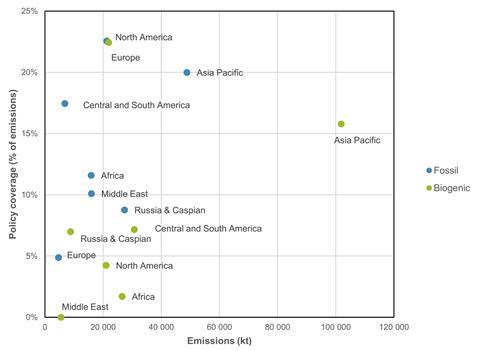Policies that aim to cut methane cover just 13% of global emissions. Even then, their impact is uncertain because they largely rely on estimates of emissions rather than direct measurements.
That’s according to a review of over 250 energy, waste and agriculture policies currently in force, ranging from economic, such as emission trading systems, to regulatory and information instruments. Around half target methane from fossil fuels, and most have been adopted in North America, Europe and Asia–Pacific.
Methane’s short-lived but powerful warming impact means mitigation is a vital tool to limit global warming. But while policy making has ramped up over the past decade, methane emissions are increasing.
The review authors point out that reporting of emissions is inaccurate and often underestimated creating a barrier to effective policy, with bottom-up and self-reported data producing different results from satellite observations. Credible baselines are lacking.
Last month the Canadian government reported a 34% decrease in methane emissions from the oil and gas industry, compared with 2012. However the government’s independent auditor found that large sources of emissions were unaccounted for and not covered by existing regulations, making the reductions uncertain.

The researchers found that most policies focused on prevention and reduction of emissions, with only one in five having the explicit objective of improving emissions monitoring. Developments in measurement technologies from ground monitors to satellites are contributing, but robust reporting and verification are needed to make policy more effective.
There are also policy blind spots. ‘In agriculture, it’s enteric fermentation, whereas in the coal mining sector its ventilation of methane which is the major source of emissions,’ says review author Maria Olczak.
Polices in the energy sector mainly target upstream emissions, whereas abandoned mines and wells are a significant source of emissions. This should be rectified at EU level, where earlier this month parliament also voted to extend requirements for monitoring and leak detection and repair to fossil imports.
Policy also has to be put into practice. Jonathan Banks at the Clean Air Task Force, who works with governments and companies around the world to develop methane policies, agrees that ‘there’s a clear distinction between a policy that’s on a piece of paper, and a policy that’s implemented. I think that we have all focused so much on trying to get the initial set of policies in place, I don’t think any of us have spent enough time focused on the implementation.’
Good policy is also an iterative process. The US state of Colorado is on its fifth round of policy development for emissions from the oil and gas sector. ‘Each time they passed [a regulation], they learned from it, and came back and improved it. We have to start with something. There’s tons of no regrets actions that we can take and those will lead to a better understanding of what’s actually happening,’ Banks adds.
Olczak is excited by the UN Environment Programme’s Methane Alert and Response System, launched at COP27. It will gather data from satellites. Alongside, the UN Environment Programme’s International Methane Emissions Observatory it will pull together data from a wide range of sources to alert governments and companies to emissions sources. One question, says Olczak, ‘is whether governments and companies are willing to act based on the data’.
In 2019, satellites identified a methane super-emitter in Turkmenistan, information that was shared ‘at a diplomatic level’. The researchers at SRON Netherlands Institute for Space Research noticed the emissions stopped for some months, before being detected again at similar levels. Turkmenistan, one of the world’s worst super-emitters, is also an example of unintended policy consequences. A ban on flaring of gas produced at oil wells seemingly led to operators shifting to venting, something that was identified by satellite data.
References
M Olczak, A Piebalgs and P Balcombe, One Earth, 2023, 6, 519 (DOI: 10.1016/j.oneear.2023.04.009)

















No comments yet